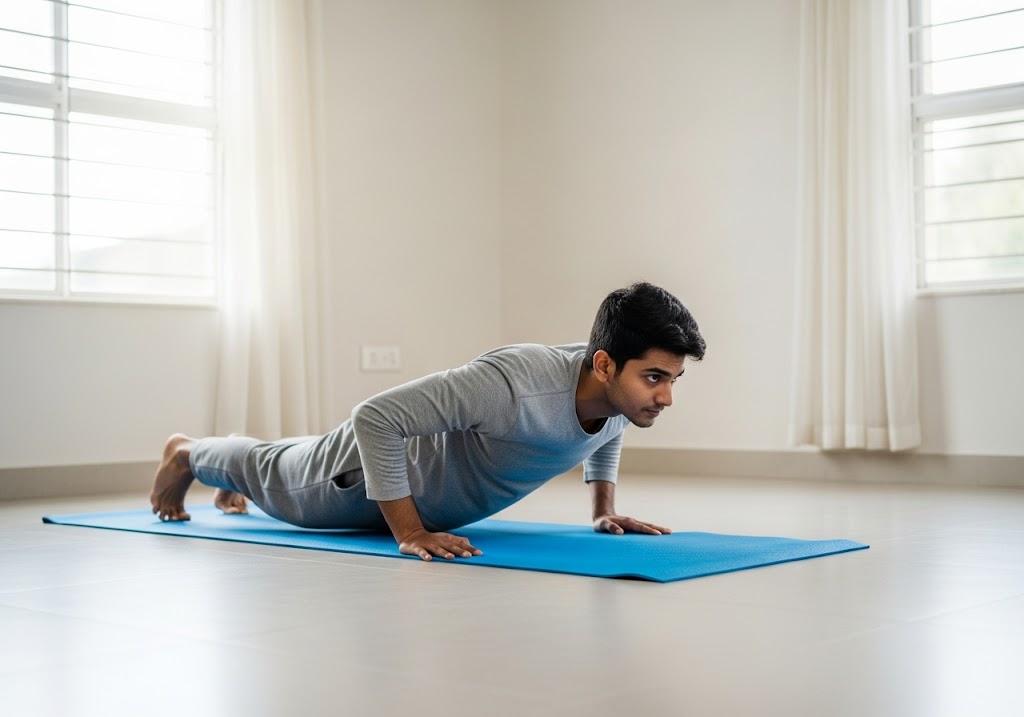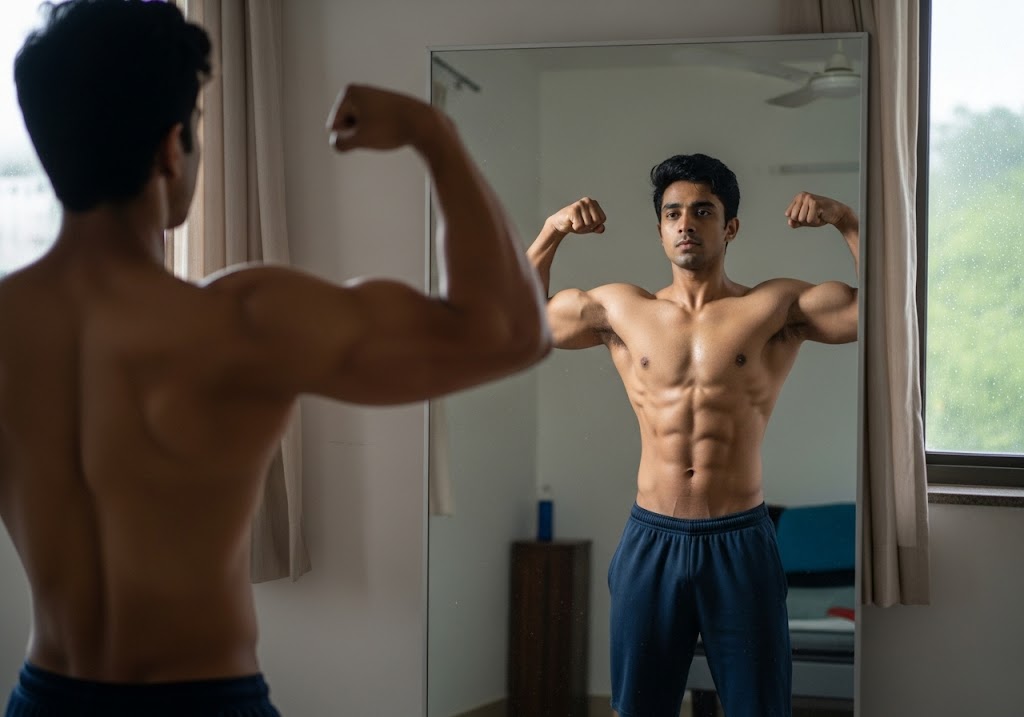100 Squats Burn How Many Calories? 100 squats burn approximately 30-50 calories for most people, depending on body weight, intensity, and squat variation. Heavier individuals burn more calories, while lighter people burn fewer calories during the same exercise session.
Wondering exactly how many calories does 100 squats burn for your weight loss goals? The answer varies based on several factors including your body weight, exercise intensity, and squat technique. Generally, 100 squats burn how many calories ranges from 30-50 calories for most adults, making squats an effective exercise for burning calories and building lower body strength simultaneously.
Understanding how many calories burned by 100 squats helps you plan effective workout routines and set realistic weight loss expectations. This complete guide covers everything from basic calorie calculations to advanced squat variations that maximize calorie burn for optimal fitness results and sustainable weight management.
Table of Contents
How Many Calories Does 100 Bodyweight Squats Burn?
The calorie burn from 100 bodyweight squats depends primarily on your body weight and exercise intensity. Research shows that squats burn approximately 0.3-0.5 calories per repetition for average-weight individuals, making 100 squats burn how many calories fall within the 30-50 calorie range for most people. Your metabolic rate, muscle mass, and exercise form also influence how many calories do you burn by doing 100 squats. Heavier individuals with more muscle mass typically burn more calories due to increased energy demands, while lighter individuals may burn fewer calories during the same exercise duration and intensity.
| Body Weight | Calories per 100 Squats | Calories per Squat | Time Required |
|---|---|---|---|
| 120 lbs (54 kg) | 25-35 calories | 0.25-0.35 | 5-8 minutes |
| 150 lbs (68 kg) | 30-40 calories | 0.30-0.40 | 5-8 minutes |
| 180 lbs (82 kg) | 35-45 calories | 0.35-0.45 | 5-8 minutes |
| 200 lbs (91 kg) | 40-50 calories | 0.40-0.50 | 5-8 minutes |
| 220 lbs (100 kg) | 45-55 calories | 0.45-0.55 | 5-8 minutes |
For comprehensive bodyweight training that complements squat workouts, exploring bodyweight exercises for beginners provides excellent foundational movements for complete fitness development.
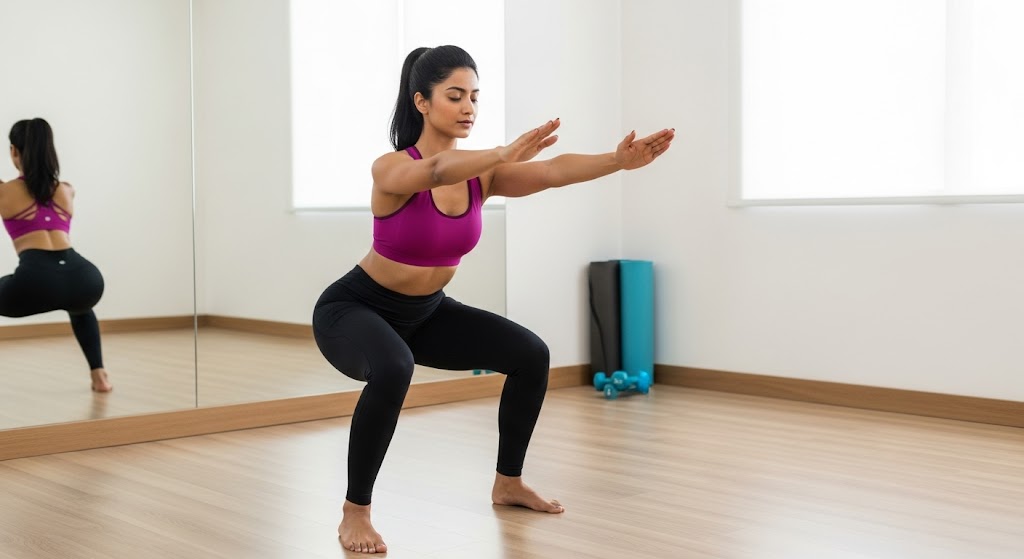
How Many Squats to Burn 100 Calories?
To burn 100 calories through squats, most people need to perform approximately 200-300 repetitions depending on their body weight and intensity level. This calculation helps answer how many squats to burn 100 calories by working backward from the average calorie burn per squat repetition. Heavier individuals may need fewer squats to reach 100 calories burned, while lighter people require more repetitions to achieve the same caloric expenditure. The key is maintaining proper form throughout all repetitions to maximize calorie burn while preventing injury and ensuring exercise effectiveness.
- Lightweight individuals (54-64 kg): Need 280-300 squats to burn 100 calories
- Average weight individuals (68-77 kg): Need 250-280 squats to burn 100 calories
- Heavier individuals (82-91 kg): Need 200-250 squats to burn 100 calories
- Very heavy individuals (100+ kg): Need 180-220 squats to burn 100 calories
- High-intensity variations: May reduce required repetitions by 20-30%
Explore the key differences in sit ups vs crunches and find out which one is better for your core goals.
How to Do Squats?
Proper squat technique maximizes calorie burn while preventing injury during your quest to understand 100 squats burn how many calories. Perfect form ensures maximum muscle activation and energy expenditure throughout each repetition for optimal results.
Basic Squat Form
Mastering basic squat form ensures you get maximum calorie burn when determining how many calories does 100 squats burn. Proper technique activates more muscles and increases energy expenditure compared to poor form execution.
Stand with feet shoulder-width apart, toes slightly pointed outward for natural hip alignment. Keep your chest up and core engaged throughout the entire movement. Lower your body by pushing hips back as if sitting into an invisible chair behind you. Descend until thighs are parallel to the ground, then drive through heels to return to standing position.
See how many calories a plank burns and how to improve your core workout.
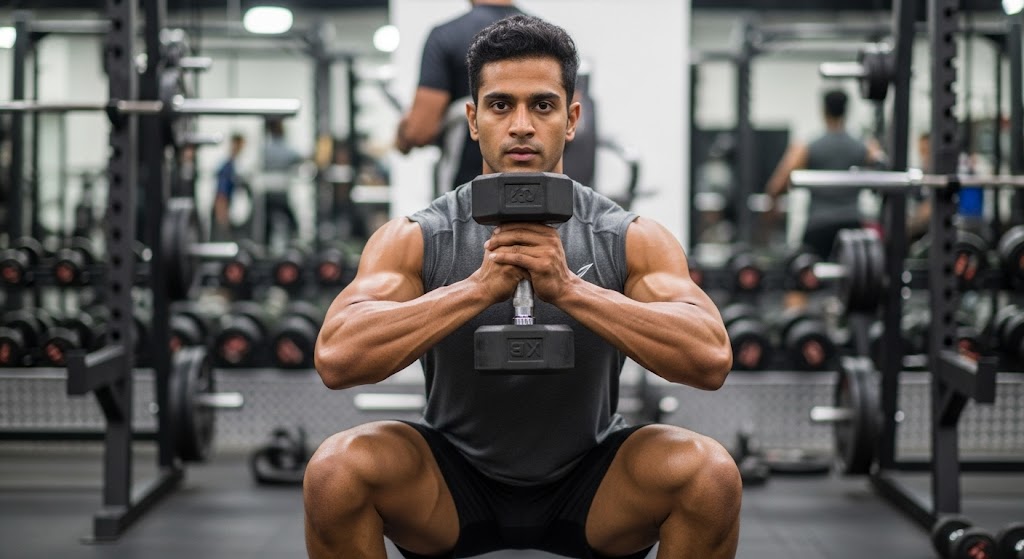
Common Form Mistakes
Poor squat form reduces calorie burn and increases injury risk when working toward your 100 squats burn how many calories goals. Avoiding these mistakes ensures maximum effectiveness and safety during every repetition.
Knee valgus (knees caving inward) reduces muscle activation and limits calorie burn potential. Forward lean shifts weight to your toes and reduces glute activation. Partial range of motion limits muscle engagement and decreases overall energy expenditure. Rushing through repetitions reduces time under tension and calorie burning effectiveness.
For comprehensive fitness routines that include proper squat technique, full body calisthenics workout provides structured training approaches for complete development.
5 Squats to Try to Burn Calories
These five squat variations increase calorie burn beyond standard bodyweight squats, helping you maximize the answer to 100 squats burn how many calories. Each variation targets different muscle groups while increasing energy expenditure through added complexity and intensity.
| Squat Variation | Calorie Multiplier | Difficulty | Primary Benefits |
|---|---|---|---|
| Jump Squats | 1.5-2x standard | High | Explosive power, cardio |
| Pulse Squats | 1.3-1.5x standard | Medium | Time under tension |
| Single-Leg Squats | 2-2.5x standard | Very High | Unilateral strength |
| Sumo Squats | 1.2-1.4x standard | Medium | Inner thigh focus |
| Overhead Squats | 1.4-1.7x standard | High | Full body engagement |
For advanced single-limb training techniques, unilateral exercises provides comprehensive guidance for balanced strength development.
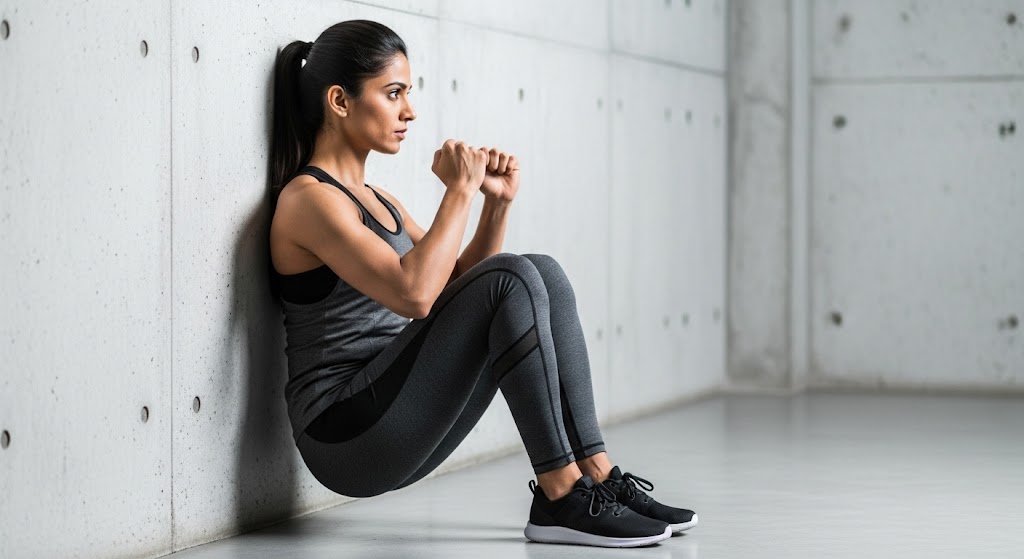
Benefits of Squats
Understanding squat benefits motivates consistent training while maximizing the calorie burn from wondering 100 squats burn how many calories. These advantages extend beyond simple calorie expenditure to include strength, mobility, and functional movement improvements that enhance daily life activities. Squats build powerful leg muscles including quadriceps, hamstrings, and glutes while engaging core stabilizers throughout each repetition. This multi-muscle activation increases metabolic demand and contributes to higher calorie burn during and after exercise sessions through elevated oxygen consumption.
Functional Strength: Improves daily activities like standing, sitting, and lifting objects
Muscle Building: Develops lower body mass that increases resting metabolic rate
Bone Density: Weight-bearing exercise strengthens bones and prevents osteoporosis
Athletic Performance: Enhances jumping, running, and change-of-direction abilities
Posture Improvement: Strengthens posterior chain muscles that combat desk-job posture
Metabolic Boost: Increases calorie burn during and hours after exercise completion
Popular Squat Variations
Popular squat variations help you maximize the answer to how many calories do you burn by doing 100 squats through increased intensity and muscle engagement. These modifications prevent boredom while challenging your body in new ways for continued progress and calorie burning effectiveness.
- Goblet Squats: Goblet squats add external resistance while improving squat form and increasing calorie burn beyond standard bodyweight calculations. Hold a weight at chest level to increase difficulty and energy expenditure during each repetition.
- Bulgarian Split Squats: Bulgarian split squats challenge single-leg strength while significantly increasing how many calories does 100 squats burn through unilateral training demands. This rear-foot-elevated variation targets each leg independently while requiring core stability and balance control.
- Wall Sits: Wall sits build isometric strength while burning calories through sustained muscle contraction and energy expenditure. Hold a squat position against a wall to develop endurance and mental toughness while contributing to overall calorie burning goals.
How Many Squats Per Day?
Determining optimal daily squat volume balances calorie burning goals with recovery needs when considering 100 squats burn how many calories in your fitness routine. Most beginners can safely perform 50-100 squats daily, while advanced individuals may handle 200-300 repetitions with proper progression and recovery protocols. Your current fitness level, goals, and available recovery time influence ideal daily squat numbers. Beginners should start with 25-50 squats and gradually increase volume over weeks to prevent overuse injuries while building strength and endurance progressively.
| Experience Level | Daily Squats | Weekly Total | Progression |
|---|---|---|---|
| Beginner | 25-50 | 175-350 | Add 5-10 weekly |
| Intermediate | 75-150 | 525-1050 | Add 10-25 weekly |
| Advanced | 200-300 | 1400-2100 | Vary intensity |
| Elite | 300+ | 2100+ | Periodize training |
For structured training approaches that complement squat routines, how to start calisthenics provides foundational guidance for comprehensive fitness development.
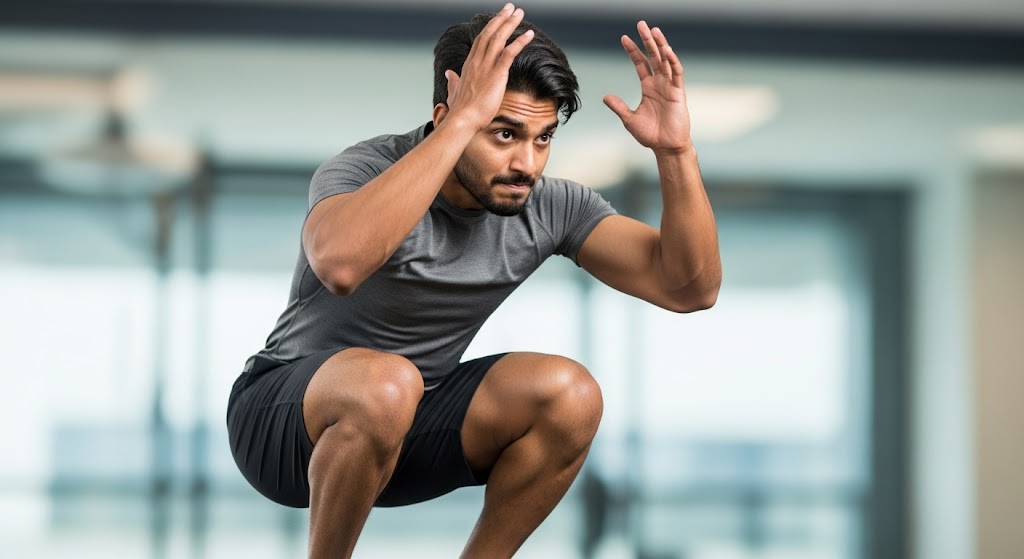
Squats for Weight Loss
Squats contribute to weight loss through direct calorie burn and long-term metabolic improvements when understanding 100 squats burn how many calories in your overall fitness strategy. While squats alone won’t create significant weight loss, they form an important component of comprehensive weight management programs. The muscle-building effects of regular squat training increase resting metabolic rate, helping you burn more calories throughout the day even when not exercising. This metabolic boost amplifies the immediate calorie burn from wondering how many calories does 100 squats burn into sustained fat loss benefits over time.
Squats and Fat Loss
Squats support fat loss through increased muscle mass and metabolic rate elevation that extends beyond immediate calorie burning calculations. Regular squat training builds lean muscle tissue that requires more energy to maintain than fat tissue.
Integration with Cardio
Combining squats with cardiovascular exercise maximizes weight loss potential beyond simple 100 squats burn how many calories calculations. This combination approach addresses both immediate calorie burning and long-term metabolic improvements for sustained fat loss results.
For comprehensive weight loss strategies, calisthenics for weight loss provides detailed approaches for effective fat burning through bodyweight training.
How Many Calories Do Squats Burn With Weights?
Adding weights significantly increases how many calories does 100 squats burn by increasing resistance and muscle activation throughout each repetition. Weighted squats can increase calorie burn by 50-100% compared to bodyweight versions depending on the weight used and individual factors. The added resistance forces your muscles to work harder, increasing energy expenditure and oxygen consumption during and after exercise. This elevated metabolic demand amplifies the answer to 100 squats burn how many calories when external resistance is incorporated into your training routine.
| Weight Added | Calorie Increase | Total Burn (68kg person) | Difficulty Level |
|---|---|---|---|
| Bodyweight Only | Baseline | 30-40 calories | Beginner |
| 4.5-9 kg | +25% increase | 37-50 calories | Beginner-Intermediate |
| 11-18 kg | +50% increase | 45-60 calories | Intermediate |
| 20-29 kg | +75% increase | 52-70 calories | Advanced |
| 32+ kg | +100% increase | 60-80 calories | Expert |
For resistance training alternatives that complement weighted squats, resistance band workouts for men provides portable strength training options.

How Much Does 30 Squats Burn?
Understanding how much 30 squats burn helps gauge progress toward larger goals like determining 100 squats burn how many calories for your fitness routine. Generally, 30 squats burn approximately 9-15 calories for most adults, providing a manageable starting point for beginners. This calorie burn scales proportionally with your total squat volume, making 30 squats an excellent daily minimum for maintaining lower body strength and contributing to overall energy expenditure. Consistent daily practice with 30 squats builds the foundation for progressing to higher volumes over time.
- 54 kg person: Burns approximately 8-10 calories with 30 squats
- 68 kg person: Burns approximately 9-12 calories with 30 squats
- 82 kg person: Burns approximately 11-14 calories with 30 squats
- 91 kg person: Burns approximately 12-15 calories with 30 squats
- 100 kg person: Burns approximately 14-17 calories with 30 squats
What Will 100 Squats For 30 Days Do?
Performing 100 squats for 30 days creates noticeable improvements in leg strength, endurance, and muscle tone while contributing 900-1500 total calories burned throughout the challenge. This consistent practice builds the habit of daily exercise while developing functional lower body strength and movement quality. The cumulative effect of daily squat practice extends beyond simple calorie calculations to include improved posture, enhanced athletic performance, and increased confidence in physical abilities. Most participants report noticeable changes in leg strength and endurance within the first two weeks of consistent practice.
Physical Changes
Daily squat practice for 30 days produces measurable improvements in leg strength, muscle endurance, and movement quality when considering 100 squats burn how many calories as part of comprehensive fitness development. Participants typically experience increased leg muscle definition, improved squat depth and form, enhanced core stability, and better overall lower body function. These changes contribute to improved daily activities and athletic performance beyond simple calorie burning benefits.
Mental Benefits
Completing a 30-day squat challenge builds mental resilience and establishes consistent exercise habits that extend beyond wondering how many calories does 100 squats burn. This achievement creates confidence for tackling larger fitness goals and challenges. The daily commitment required develops discipline and routine that often transfers to other areas of life including nutrition, sleep, and stress management. Many participants use squat challenges as stepping stones to more comprehensive fitness programs and lifestyle changes.
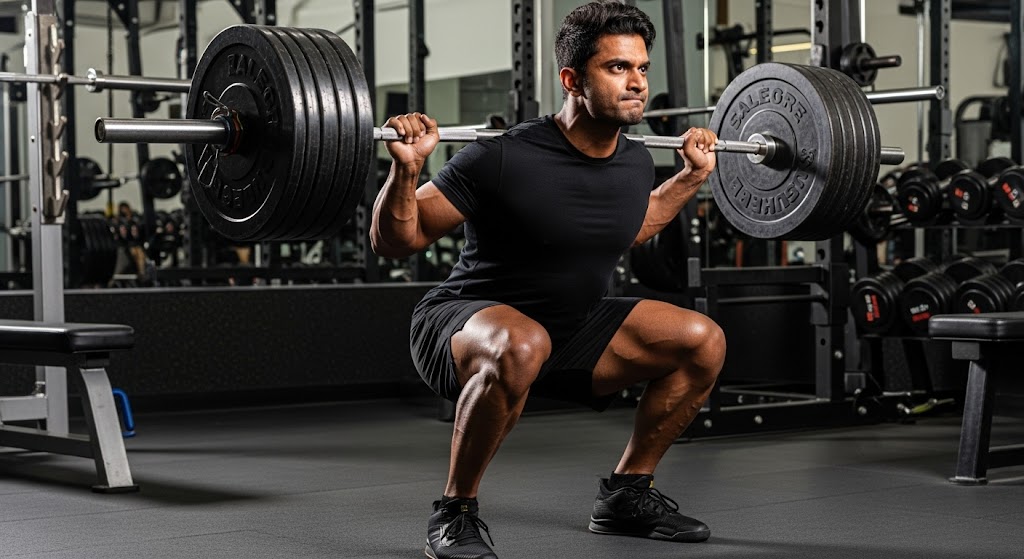
Should You Do 100 Squats For 30 Days?
Whether you should commit to 100 squats for 30 days depends on your current fitness level, goals, and ability to maintain proper form throughout higher repetition ranges. While understanding 100 squats burn how many calories provides motivation, the decision should consider individual factors and circumstances. Beginners may benefit more from starting with 25-50 squats daily and focusing on perfect form rather than arbitrary numbers. Advanced individuals might find 100 squats insufficient challenge and benefit from weighted variations or more comprehensive training programs that include multiple exercises and movement patterns.
Pros of the Challenge
The 30-day squat challenge provides structure, builds habits, and creates measurable progress when considering how many calories burned by 100 squats as part of your fitness journey. It requires minimal time commitment and no equipment while delivering tangible results.
Cons of the Challenge
High-repetition squat challenges may lead to overuse injuries, muscle imbalances, and boredom when focusing solely on one exercise. The narrow focus limits overall fitness development compared to comprehensive training programs that address multiple movement patterns and muscle groups.
For balanced training approaches, warm up exercises for beginners provides essential preparation for safe and effective exercise sessions.
Tips to Maximize the Benefits
Maximizing squat benefits extends beyond understanding 100 squats burn how many calories to include form optimization, progression strategies, and recovery protocols. These tips ensure you get maximum results from your squat training while preventing injury and maintaining long-term progress. Focus on quality over quantity by maintaining perfect form throughout all repetitions rather than rushing through high numbers with poor technique. Perfect form maximizes muscle activation and calorie burn while reducing injury risk and ensuring long-term training sustainability.
Progressive Overload: Gradually increase repetitions, add weights, or use advanced variations
Proper Recovery: Allow 48-72 hours between intense squat sessions for muscle repair
Form Focus: Prioritize perfect technique over speed or high repetition counts
Variation: Include different squat types to prevent adaptation and maintain interest
Breathing: Maintain consistent breathing patterns to optimize oxygen delivery and performance
Warm-up: Always prepare muscles with dynamic movements before intense squat sessions
Long-Term Effects of Doing 100 Squats Daily
Long-term daily squat practice creates substantial improvements in lower body strength, bone density, and functional movement capacity that extend far beyond simple calculations of 100 squats burn how many calories. These adaptations contribute to healthier aging and improved quality of life over years and decades. Consistent squat training builds muscle mass that helps maintain metabolic rate with aging, reduces fall risk through improved balance and leg strength, and preserves bone density through weight-bearing exercise stimulus. These benefits compound over time to create significant long-term health improvements and enhanced physical capabilities.
Muscle Adaptations
Daily squat practice creates progressive muscle adaptations including increased strength, endurance, and size in major leg muscles when considering how many calories do you burn by doing 100 squats as part of comprehensive fitness development. These adaptations improve functional activities like climbing stairs, standing from chairs, and lifting objects from the ground. The enhanced muscle development also increases resting metabolic rate, contributing to long-term weight management and body composition improvements.
Joint Health
Regular squat practice improves hip, knee, and ankle mobility while strengthening surrounding muscles that support joint health and function throughout life. This maintenance of joint range of motion and stability prevents age-related movement limitations and maintains independence. The weight-bearing nature of squats stimulates bone formation and maintains bone density, particularly important for preventing osteoporosis and fractures in later life. These benefits accumulate over years of consistent practice to create significant health advantages.
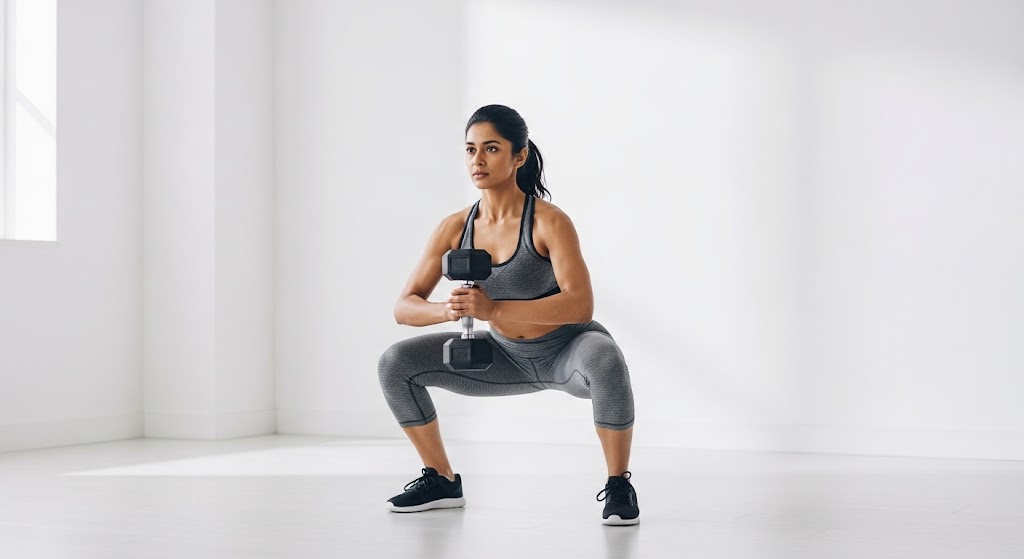
Different Types of Squats
Understanding different squat types allows you to vary training and maximize the benefits beyond basic calculations of how many calories does 100 squats burn. Each variation targets muscles differently while providing unique challenges and calorie burning potential for comprehensive lower body development. Squat variations prevent adaptation and boredom while addressing different movement planes and muscle activation patterns. This variety ensures continued progress and maintains interest in long-term training programs that include squats as fundamental movement patterns.
Bodyweight Variations
Bodyweight squat variations provide endless progression possibilities without requiring equipment when exploring 100 squats burn how many calories in your training routine. These modifications increase difficulty and calorie burn through altered leverage, range of motion, and stability challenges.
Weighted Variations
Weighted squat variations significantly increase calorie burn and strength development potential when considering how many calories burned by 100 squats with added resistance. External loads challenge muscles in new ways while dramatically increasing energy expenditure during training sessions.
For advanced strength training techniques, does calisthenics build muscle explores bodyweight training effectiveness for muscle development.
Short-Term Effects of Doing 100 Squats a Day
Short-term effects of daily squat practice become apparent within days to weeks when consistently performing routines that consider 100 squats burn how many calories as part of overall fitness goals. These immediate adaptations provide motivation and feedback for continued progress and program adherence. Initial effects include improved squat form and technique, enhanced muscle endurance in leg muscles, increased heart rate response to exercise, and greater awareness of lower body muscle activation patterns. These changes create the foundation for long-term adaptations and continued improvement over time.
Week 1-2 Changes
The first two weeks of daily squat practice produce noticeable improvements in movement quality and exercise tolerance when focusing on how many calories do you burn by doing 100 squats consistently. Initial soreness gives way to improved recovery and adaptation.
Week 3-4 Changes
By the third and fourth weeks, strength and endurance improvements become more pronounced while exercise form continues to refine. The cardiovascular response to squat training improves, making the sessions feel easier despite maintained or increased intensity levels.
Common Squat Injuries and How to Avoid Them?
Preventing squat injuries ensures long-term training success while safely pursuing goals related to 100 squats burn how many calories. Understanding common injury patterns and prevention strategies allows you to maintain consistent training without setbacks or pain that interrupts progress. The most common squat injuries include knee pain from poor tracking, lower back strain from excessive forward lean, and ankle discomfort from mobility limitations. These issues typically result from form errors, inadequate warm-up, or progression that exceeds current capacity and recovery abilities.
Knee Injuries
Knee injuries during squats often result from valgus collapse (knees caving inward) or excessive forward knee movement when pursuing how many calories does 100 squats burn goals. Proper form and adequate strength development prevent these common injury patterns.
Lower Back Injuries
Lower back injuries typically occur from excessive forward lean or loss of neutral spine positioning during squat movements. Maintaining upright torso position and engaging core muscles throughout the movement prevents most lower back problems during squat training.
For recovery techniques that support training, what is foam rolling provides essential muscle maintenance strategies.
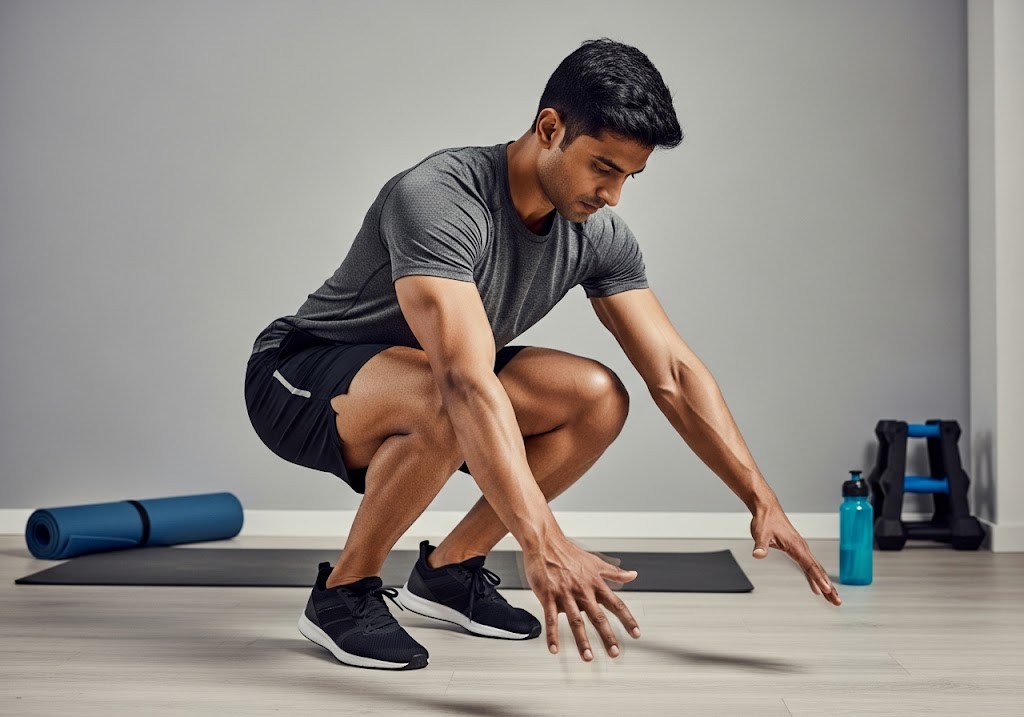
Advanced Squat Variations for Strength
Advanced squat variations challenge experienced practitioners beyond basic calculations of 100 squats burn how many calories by incorporating complex movement patterns and increased resistance demands. These progressions continue strength development and prevent adaptation plateaus in long-term training programs. Advanced variations require excellent mobility, stability, and strength foundations before attempting them safely and effectively. Progress gradually through basic versions before advancing to prevent injury and ensure proper movement quality throughout increased complexity and difficulty levels.
Pistol Squats
Pistol squats represent the ultimate bodyweight squat challenge, requiring exceptional single-leg strength, balance, and mobility when considering how many calories burned by 100 squats in advanced variations. This unilateral movement dramatically increases difficulty and calorie burn potential.
Overhead Squats
Overhead squats challenge total-body stability and mobility while significantly increasing the energy cost beyond standard squat calorie calculations. This full-body movement requires shoulder flexibility, core strength, and perfect squat mechanics for safe execution.
For advanced bodyweight challenges, calisthenics planche and calisthenics human flag provide ultimate strength development goals.
Squats vs Lunges
Comparing squats and lunges helps optimize exercise selection when considering calorie burn and muscle development goals beyond simple questions of 100 squats burn how many calories. Both exercises offer unique benefits and can complement each other in comprehensive training programs. Squats generally allow for heavier loading and bilateral strength development, while lunges provide unilateral challenges and address different movement planes. The choice between exercises depends on specific goals, current abilities, and program design considerations for optimal results.
| Comparison Factor | Squats | Lunges | Winner |
|---|---|---|---|
| Calorie Burn | Moderate-High | Moderate | Squats |
| Balance Challenge | Low | High | Lunges |
| Loading Potential | High | Moderate | Squats |
| Unilateral Benefits | Low | High | Lunges |
| Learning Curve | Easy | Moderate | Squats |
| Space Requirements | Minimal | Moderate | Squats |
For comprehensive exercise comparisons, jumping jacks exercise benefits explores another popular calorie-burning movement option.
Conclusion
Understanding 100 squats burn how many calories provides valuable insight for weight loss and fitness planning, with most people burning 30-50 calories per 100 repetitions. This calorie burn varies based on body weight, intensity, and squat variation, making squats an effective component of comprehensive fitness programs. While the immediate calorie burn from 100 squats is modest, the long-term benefits of regular squat training include increased muscle mass, improved metabolic rate, and enhanced functional strength that contribute to sustainable weight management and overall health improvements throughout life.
Want to master the calisthenics handstand and take your skills to the next level? Whether you’re a beginner or pushing advanced skills, ISC – Indian School of Calisthenics offers expert guidance to help you master bodyweight training. Visit us at SRPF Ground, NH8, Goregaon (E), Mumbai – 400065. For class schedules, personalized coaching, or more details, call +91 77159 53218. Train smart, move better, and unlock your back strength with ISC.
100 Squats Burn How Many Calories – FAQs
Why are sit-ups no longer recommended?
Sit-ups are discouraged because they stress the spine and neck while providing limited core strength benefits compared to safer alternatives.
Is 100 squats a day enough to lose weight?
100 squats daily burns only 30-50 calories, insufficient alone for weight loss but beneficial as part of comprehensive programs.
How many calories do you burn in 50 squats?
50 squats burn approximately 15-25 calories for most people, depending on body weight and exercise intensity levels.
Do squats burn belly fat?
Squats don’t directly target belly fat but build muscle mass that increases metabolic rate and supports overall fat loss.
How to burn 1000 calories a day?
Combine high-intensity cardio, strength training, and daily activities; squats alone would require 2000-3000 repetitions to burn 1000 calories.
How many squats equal 10,000 steps?
No direct equivalent exists, but 10,000 steps burn 300-500 calories while requiring 600-1000 squats for similar expenditure.
Is 200 squats a day good?
200 daily squats provide excellent lower body conditioning and burn 60-100 calories, making them beneficial for fitness goals.
How to lose thigh fat?
Combine squats with cardio, proper nutrition, and full-body strength training; spot reduction isn’t possible through exercise alone.
Is 75 squats a day good?
75 daily squats offer good lower body conditioning and burn 22-37 calories, providing excellent foundation for fitness development.
What exercise burns the most belly fat?
High-intensity interval training and compound exercises burn the most calories and support belly fat loss through metabolic elevation.

